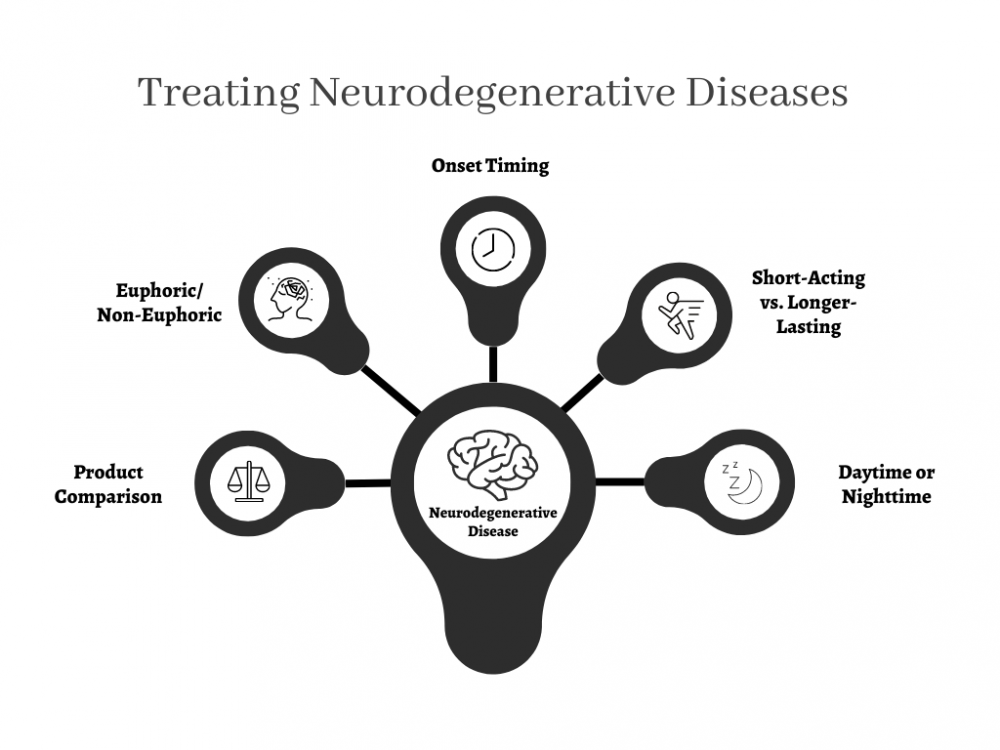
Treating Neurodegenerative Diseases with Cannabinoids: Advancing Beyond Symptom Management
Neurodegenerative diseases, such as Alzheimer’s, Parkinson’s, and Huntington’s, pose significant challenges for patients and their families. Emerging research suggests that cannabinoids, along with terpenes and flavonoids found in cannabis, hold promise in the treatment of these conditions. However, it is important to distinguish between disease treatment and symptom management when considering the use of cannabinoids.
Cannabinoids for Neurodegenerative Disease Treatment: Cannabinoids, the chemical compounds found in cannabis, have been studied for their potential neuroprotective and anti-inflammatory effects. Research has shown that cannabinoids, such as CBD and THC, may help alleviate neurodegenerative symptoms by modulating the endocannabinoid system, reducing oxidative stress, and promoting neurogenesis. These effects have sparked interest in exploring cannabinoids as potential disease-modifying agents.
Terpenes and Flavonoids: Enhancing Therapeutic Potential: In addition to cannabinoids, cannabis contains various terpenes and flavonoids that contribute to its therapeutic properties. Terpenes, such as myrcene and limonene, have been shown to possess anti-inflammatory, antioxidant, and neuroprotective effects. Flavonoids, on the other hand, exhibit anti-inflammatory and neuroprotective properties. The synergistic effects of cannabinoids, terpenes, and flavonoids, known as the entourage effect, may enhance the therapeutic potential of cannabis-based treatments for neurodegenerative diseases.
Disease Treatment vs Symptom Management: While cannabinoids may provide relief from symptoms associated with neurodegenerative diseases, it is important to differentiate between disease treatment and symptom management. Currently, the scientific evidence supporting cannabinoids’ ability to halt or reverse the progression of these diseases is limited. However, cannabinoids have shown promise in managing symptoms such as pain, inflammation, sleep disturbances, and motor dysfunction.
Comparing Products: Euphoric vs Non-Euphoric: Cannabis products can be classified as either euphoric (containing THC) or non-euphoric (mainly CBD). Euphoric products may provide additional benefits for symptom management, including pain relief and improved mood. Non-euphoric products, on the other hand, offer potential therapeutic benefits without the psychoactive effects. The choice between euphoric and non-euphoric products depends on individual preferences, medical conditions, and desired outcomes.
Onset of Action: Methods of Consumption: The onset of action of cannabinoids can vary depending on the method of consumption. Inhalation (smoking or vaporization) provides rapid onset, with effects typically felt within minutes. Oral consumption (edibles, capsules) takes longer to take effect, often requiring 1-2 hours due to digestion and metabolism. Sublingual administration (tinctures, sprays) offers a balance between rapid onset and longer duration. Understanding the different methods and their respective onset times can help individuals tailor their cannabinoid use to their specific needs.
Short-acting and Long-acting Solutions: Cannabinoid products can also be categorized as short-acting or long-acting. Short-acting solutions provide immediate relief but have a shorter duration of action, requiring more frequent dosing. Long-acting solutions, such as extended-release formulations, offer sustained relief, reducing the frequency of administration. Selecting the appropriate duration of action depends on the severity of symptoms, individual response, and lifestyle considerations.
Relevance for Daytime vs Nighttime Use: Considering the effects of cannabinoids on alertness and sedation is crucial when determining daytime or nighttime use. Non-euphoric products, like CBD-dominant strains, are often preferred for daytime use as they are less likely to cause drowsiness. However, euphoric products containing THC may be beneficial for nighttime use, aiding in sleep, relaxation, and pain management. Individual tolerance, sensitivity, and personal schedules should be considered when deciding the timing of cannabinoid use.
Please note that while there is a growing body of scientific research on cannabinoids and neurodegenerative diseases, it is always important to consult with medical professionals and rely on peer-reviewed studies for personalized treatment decisions.
References:
- Aso E, et al. (2016). PLOS ONE. https://doi.org/10.1371/journal.pone.0150988
- Russo EB. (2011). British Journal of Pharmacology. https://doi.org/10.1111/j.1476-5381.2011.01238.x
- Baron EP. (2018). Innovations in Clinical Neuroscience. https://www.ncbi.nlm.nih.gov/pmc/articles/PMC6164964/
- Russo EB. (2019). Frontiers in Integrative Neuroscience. https://doi.org/10.3389/fnint.2018.00051
- Pisanti S, et al. (2019). Trends in Pharmacological Sciences. https://doi.org/10.1016/j.tips.2019.04.009
📗 Note: If this diagram got your attention, the book will be your full-blown study session. Get schooled with “The Doctor-Approved Cannabis Handbook” right here 📗.

Summary Notes
Exploring the Frontier: Cannabinoids in Neurodegenerative Disease Treatment
The application of cannabinoids in treating neurodegenerative diseases represents a promising frontier, extending beyond traditional symptom management to potentially modifying disease progression. This exploration delves into the therapeutic potentials of cannabinoids like CBD and THC in conditions such as Alzheimer’s, Parkinson’s, and multiple sclerosis, highlighting their neuroprotective, anti-inflammatory, and antioxidative properties.
Clinical trials and patient outcomes underscore the significance of cannabinoids in alleviating symptoms and improving quality of life, with emerging evidence suggesting their role in neuroprotection and neural regeneration. The interaction between cannabinoids and the endocannabinoid system in modulating neurodegenerative processes offers insights into novel therapeutic pathways.
Safety, dosage optimization, and the development of targeted delivery systems are paramount considerations, especially given the population typically affected by neurodegenerative diseases. The efficacy of cannabinoid therapy is further influenced by genetic, pharmacokinetic, and pharmacodynamic factors, necessitating personalized treatment approaches.
Regulatory, legal, and educational challenges persist in integrating cannabinoid-based treatments into mainstream neurodegenerative disease management. Overcoming these barriers requires comprehensive clinical research, informed public health strategies, and an interdisciplinary approach to healthcare provision.
As research progresses, the potential of cannabinoids to not only manage symptoms but also alter the course of neurodegenerative diseases is becoming increasingly apparent. This promising area of medicine calls for continued exploration, innovation, and collaboration, aiming to unlock new therapeutic potentials for cannabinoids in neurology.

